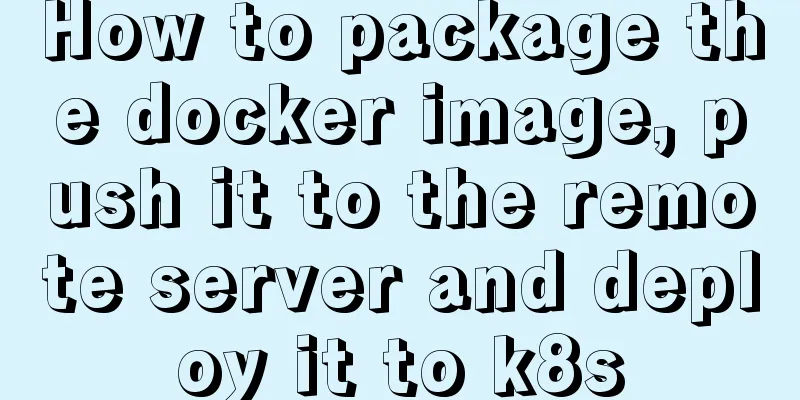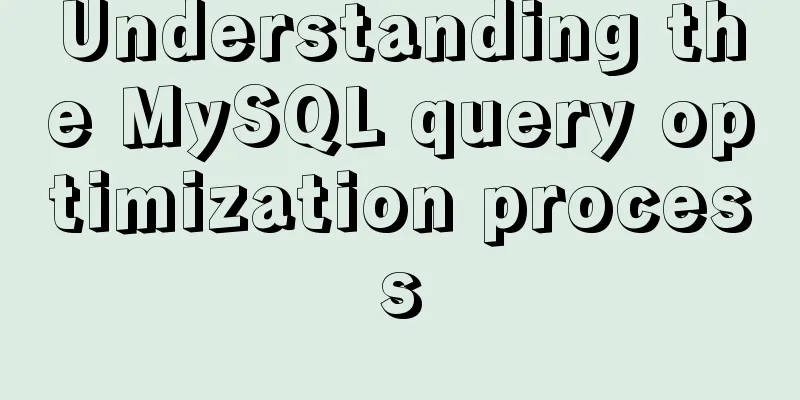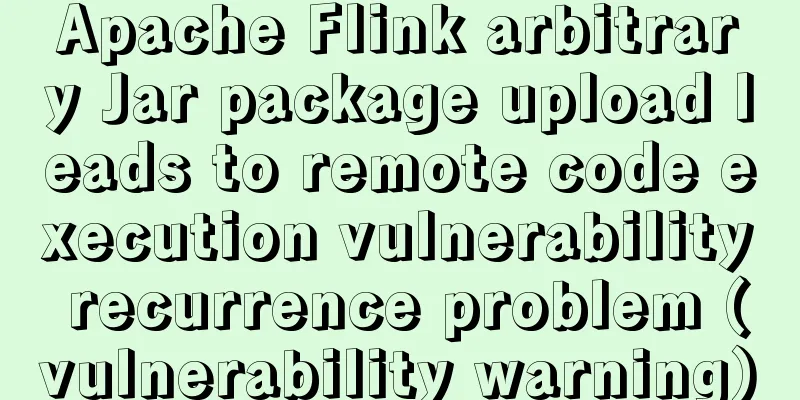How to package the docker image, push it to the remote server and deploy it to k8s

|
Prerequisites: 1. Remote access has been enabled on the Docker server. Please refer to "Remote Docker Server with Certificate Connection". 2. The k8s cluster has been built on the server. This article uses a k8s single-point cluster for testing. In the previous article, we have tested that the remote docker server can be accessed normally through the idea docker plug-in. Although this docker plug-in can also be used to package and push docker images, this article will use another way to use Maven's docker-maven-plugin plug-in to package docker images and push them to the remote docker server. 1. DockerfileThe Dockerfile file is used to make our application into a docker image # Specify the jdk environment version and create an image based on java8 FROM java:8 # Mount the temporary directory VOLUME /tmp # Add the specified jar package to the container [This is the full name of the jar package generated by the project packaging] ADD practice-job-0.0.1-SNAPSHOT.jar /practice-job.jar # The port number exposed by the container (refers to the port number occupied by the project) EXPOSE 8081 # Commands executed after the container is started ENTRYPOINT [ "java", "-Djava.security.egd=file:/dev/./urandom", "-jar", "/practice-job.jar" ] 2. pom configurationThe relevant configuration of the pom file is as follows. Pay attention to fill in the IP address of the remote server, and indicate the path of the above Dockerfile and the path of the pem certificate file required to access the remote docker.
<build>
<plugins>
<plugin>
<groupId>org.springframework.boot</groupId>
<artifactId>spring-boot-maven-plugin</artifactId>
</plugin>
<!--Use the docker-maven-plugin plugin to package the service into an image and send it to the docker server-->
<plugin>
<groupId>com.spotify</groupId>
<artifactId>docker-maven-plugin</artifactId>
<version>1.2.2</version>
<!--Bind the plugin to a certain phase for execution-->
<executions>
<execution>
<id>build-image</id>
<!--Bind the plug-in to the package phase. That is to say, users only need to execute mvn package, which will automatically execute mvn docker:build -->
<phase>package</phase>
<goals>
<goal>build</goal>
</goals>
</execution>
</executions>
<configuration>
<forceTags>true</forceTags>
<!--Specify the generated image name. Change this to the image name you want to generate. -->
<imageName>practice-job</imageName>
<!--Specify tags-->
<imageTags>
<imageTag>latest</imageTag>
</imageTags>
<!-- Specify the Dockerfile path -->
<dockerDirectory>${project.basedir}</dockerDirectory>
<!--Specify the remote docker address-->
<dockerHost>https://public network ip:2376</dockerHost>
<!--Specify the pem certificate file path address-->
<dockerCertPath>${project.basedir}/src/main/resources/pem</dockerCertPath>
<!-- Here is the configuration for copying the jar package to the specified directory of the docker container-->
<resources>
<resource>
<targetPath>/</targetPath>
<!--The path where the jar package is located corresponds to the target directory -->
<directory>${project.build.directory}</directory>
<!-- The jar package that needs to be included, which corresponds to the file name added in Dockerfile-->
<include>${project.build.finalName}.jar</include>
</resource>
</resources>
</configuration>
</plugin>
</plugins>
</build>3. Image pushAfter the above preparations are ready, execute the install command. After waiting for a while, BUILD SUCCESS appears in the console below, indicating that the image push is successful.
Then go to the remote server to verify and enter the docker images command to view the container image.
You can see that our application image has been pushed successfully. The next step is the deployment stage. 4. k8s deploymentIf our deployment environment only had a docker container in the past, then here we only need to docker run our application image, deploy the project in the docker container and access it. But now our deployment environment is k8s+docker, so we can't directly run our application image for deployment. Let's move on to k8s deployment. First, you need to create two yaml files: practice-job-deployment.yaml and practice-job-service.yaml. The functions of these two files involve the concept of k8s. The concept of k8s will be discussed in subsequent articles. Here you only need to know that most of the configurations in k8s are defined based on yaml files. vi practice-job-deployment.yaml
apiVersion: v1
kind: Namespace
metadata:
name: practice
---
apiVersion: apps/v1
kind: Deployment
metadata:
name: practice-job-deployment
namespace: practice
spec:
replicas: 1
selector:
matchLabels:
app: practice-job-pod
template:
metadata:
labels:
app: practice-job-pod
spec:
hostNetwork: true
containers:
- name: practice-job-container
image: practice-job:latest #image name + versionimagePullPolicy: Never #Indicates the image source. IfNotPresent is not available locally, it will be pulled from the hub warehouse. Never means only from local ports:
- containerPort: 8081
env:
# Specify the log file path - name: logging.path
value: /var/logsvi practice-job-service.yaml
apiVersion: v1
kind: Service
metadata:
name: practice-job-service
namespace: practice
labels:
app: practice-job-service
spec:
type: NodePort
selector:
app: practice-job-pod
ports:
- name: http
protocol: TCP
port: 8081 #service (internal) port targetPort: 8081 #pod port nodePort: 32001 #service (external) portThen execute the commands separately: kubectl apply -f practice-job-deployment.yaml kubectl apply -f practice-job-service.yaml
Execute the command: kubectl get pod --all-namespaces. Check the pod and you can see that the pod of our project has run successfully.
Run the kubectl logs practice-job-deployment-77d685767-glvgm -n practice command to view the application running logs. The format is: kubectl logs <pod name> -n <pod namespace>.
Execute the command: docker ps You can see that the project is already running in the container
Execute the command: kubectl get service --all-namespaces. You can see that the service corresponding to the application has been started successfully and the exposed port is 32001, which is the port we configured in the yaml file earlier.
Finally, the browser accesses: public network ip:32001/doc.html. This path is just for my project, different projects have different paths. Note that the firewall needs to open the corresponding ports.
At this point, the application is packaged from the local docker image and pushed to the server, and then deployed to the k8s+docker container. This is the end of this article about the steps to package the docker image, push it to the remote server and deploy it to k8s. For more relevant docker image packaging and deployment to k8s, please search for previous articles on 123WORDPRESS.COM or continue to browse the following related articles. I hope you will support 123WORDPRESS.COM in the future! You may also be interested in:
|
<<: Learn more about the most commonly used JavaScript events
>>: How to insert weather forecast into your website
Recommend
Summary of 50+ Utility Functions in JavaScript
JavaScript can do a lot of great things. This art...
Vue uses calculated properties to complete the production of dynamic sliders
Layout part: <div id="slider"> &l...
Summary of Mysql exists usage
Introduction EXISTS is used to check whether a su...
How to limit the number of records in a table in MySQL
Table of contents 1. Trigger Solution 2. Partitio...
Detailed explanation of Nginx static file service configuration and optimization
Root directory and index file The root directive ...
How to Delete Junk Files in Linux Elegantly
I wonder if you are like me, a programmer who arr...
Complete steps to install mysql5.7 on Mac (with pictures and text)
I recently used a Mac system and was preparing to...
Detailed explanation of the solution to image deformation under flex layout
Flex layout is a commonly used layout method nowa...
Use SWFObject to perfectly solve the browser compatibility problem of inserting Flash into HTML
Let’s learn together 1. Traditional methods Copy ...
How to connect a Linux virtual machine to WiFi
In life, the Internet is everywhere. We can play ...
Sample code for achieving small triangle border effect with pure CSS3+DIV
The specific code is as follows: The html code is...
Two ways to implement square div using CSS
Goal: Create a square whose side length is equal ...
Instructions for using the --rm option of docker run
When the Docker container exits, the file system ...
CSS box hide/show and then the top layer implementation code
.imgbox{ width: 1200px; height: 612px; margin-rig...
Implementation steps for installing Redis container in Docker
Table of contents Install Redis on Docker 1. Find...


















